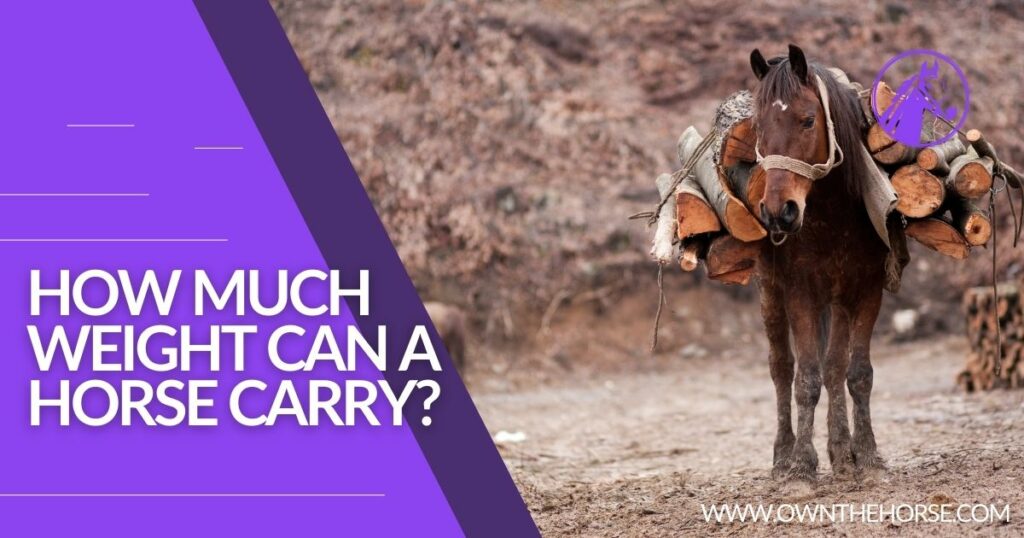As an Amazon Associate we earn from qualifying purchases.
Horses are strong animals with considerable strength and endurance. Though a horse’s capacity to carry weight varies depending on their size, breed, and fitness level, the average amount a horse can carry is around 10-20 percent of its body weight including the rider, saddle, and any other equipment.
Factors That Affect a Horse’s Capacity for Weight
Though some horses are capable of carrying more weight than others, ride weight should never exceed 20 percent of a horse’s body weight as it can easily lead to discomfort, lameness, and fatigue. Several factors can influence the amount of weight a horse can carry safely, including its:
Size
Larger horses can typically carry more weight than smaller horses due to their increased muscle mass.
Large horses tend to have thicker muscles and a larger frame than small horses, which means that they are typically able to carry more weight. This is due to their increased muscle mass, which allows them to support heavier loads for longer periods of time. Additionally, larger horses have a higher capacity for power output, which can contribute to their ability to carry more weight. And while any horse, regardless of size, can develop any injury if pushed beyond its capacity, larger horses are typically better equipped to handle larger loads due to the higher muscle mass and increased power output.
Breed
Horses of certain breeds like the Shire, Friesian, and Belgian Draft tend to be bred for equestrian sports and thus are likely to be able to carry more weight.
Certain breeds like the Shire, Friesian, and Belgian Draft horses have been specifically bred to engage in equestrian activities such as carrying a rider and additional equipment. These breeds are known for their large size and powerful muscles, which give them the ability to safely bear more weight than other breeds. In addition, they also tend to be easily trained and less prone to fatigue, making them ideal mounts for heavier riders. Lastly, many of these breeds have been selected to carry riders in traditional activities such as ploughing, hauling, and more, wherein riders have to bear a large amount of weight in addition to their horse due to the heaviness of the equipment.
Age
Younger horses aren’t usually recommended to carry a heavy load as they don’t have fully developed muscles yet.
Baby horses, or foals, have not fully developed their muscles nor have they been fully trained. Therefore, it is not recommended to carry any load on them for extended periods of time. Although some foals can carry light riders for short periods of time, it’s best to wait until they’re around two years old before attempting to carry a heavier load. Even then, it is important to monitor the horse’s progress and hold off from any strenuous activities until their muscles have developed fully and they have been properly conditioned.
Fitness Level
Horses need to be properly conditioned before carrying additional weight as they become more prone to degenerative joint and muscle conditions if they’re not in top physical form.
In order to ensure a horse is capable to carry an additional load safely, it must be properly conditioned and trained before doing so. An unconditioned horse that is suddenly asked to carry extra weight can be subjected to intense strains on its muscles and joints, resulting in fatigue, lameness, and the development of degenerative conditions. To avoid such issues, it is important to start conditioning horses slowly to prepare them for the load they will be carrying. This involves gradually increasing the amount of exercise a horse performs until it is able to support the desired load safely.
Training
Training: Horses that are trained specifically to carry additional weight can typically bear more than those that are not.
Horses are capable of learning certain behaviors with the right training and can be taught to carry more weight than what’s considered the usual amount. To achieve this, trainers can start by introducing horses to basic commands such as stopping and going, as well as teaching them to get used to heavy equipment. Once the horse is conditioned and familiar with the weight, it can be gradually exposed to increasingly heavier equipment to get it accustomed to the extra load. This will help ensure that the horse is trained properly and will be able to carry a heavier weight safely.
SEE ALSO : How Old Do You have to Be to Work in a Stable?
How to Determine If a Horse Can Carry Extra Weight
If you’re not sure if your horse can handle the weight of a rider and additional equipment, there are a few ways to determine this. One way is to consult a veterinarian and have your horse undergo a physical exam to identify any health concerns. In addition, you can monitor how your horse manages the current amount of weight before gradually increasing the load. Lastly, you should ensure your horse is properly conditioned and trained before taking them out for a ride with an added load.
Frequently Asked Questions
Q: How much weight can a horse carry?
Generally, a horse can carry 10-20 percent of its body weight, including the rider, saddle, and other equipment. However, the amount a horse can carry can depend on its size, breed, age, fitness level, and training.
Q: How can I determine if a horse can safely carry additional weight?
You can consult a veterinarian to have your horse undergo a physical exam to identify any health concerns. You can also monitor how your horse manages the current amount of weight before gradually increasing the load. Additionally, you should ensure your horse is properly conditioned and trained before taking them out for a ride with an added load.
Q: How much weight can a pony carry?
A: Ponies typically have a smaller physical stature than horses, and because of this, they can carry around 6-8 percent of their body weight, including the rider, saddle, and other equipment. However, it’s important to note that factors such as size, breed, age, fitness level, and training can affect the amount of weight a pony can safely carry.
Final Thoughts
Overall, horses are strong and capable animals that can carry a considerable amount of weight. However, the amount a horse can carry safely depends on its size, breed, age, fitness level, and training. Additionally, it’s important to never exceed 20 percent of the horse’s body weight with the rider, saddle, and other equipment, as this can lead to discomfort, lameness, and fatigue. If you’re unsure if your horse can carry additional weight, you can consult with a veterinarian to ensure your equine companion is healthy and fit enough to do so.
Amazon and the Amazon logo are trademarks of Amazon.com, Inc, or its affiliates.

Hey there, I’m Jasmine! I’m a total horse fanatic and have been working with these amazing animals for as long as I can remember. I’m passionate about sharing my love for horses with others and helping them learn more about these majestic creatures. As a professional horse trainer and riding instructor, I’ve developed a deep understanding of equine science and am committed to the welfare of horses. That’s why I founded OwnTheHorse.com, a blog where I share my knowledge and insights with fellow horse enthusiasts. I love connecting with my readers and building a friendly community of horse lovers. Whether you’re a seasoned equestrian or just starting out, I’m here to help and inspire you. Above all, I’m a friendly and compassionate person who truly cares about the well-being of horses and their human companions.

